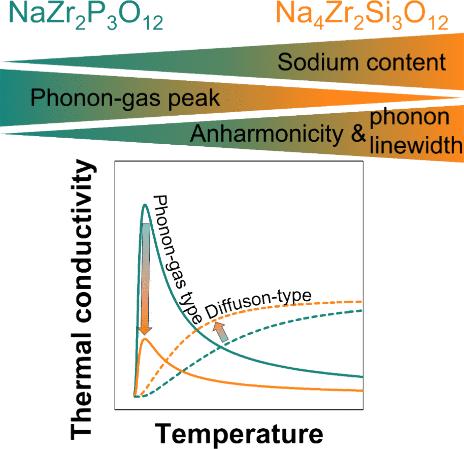当前位置:
X-MOL 学术
›
J. Am. Chem. Soc.
›
论文详情
Our official English website, www.x-mol.net, welcomes your
feedback! (Note: you will need to create a separate account there.)
On the Thermal Conductivity and Local Lattice Dynamical Properties of NASICON Solid Electrolytes
Journal of the American Chemical Society ( IF 14.4 ) Pub Date : 2024-11-13 , DOI: 10.1021/jacs.4c12034 Thorben Böger, Tim Bernges, Matthias T. Agne, Pieremanuele Canepa, Frank Tietz, Wolfgang G. Zeier
Journal of the American Chemical Society ( IF 14.4 ) Pub Date : 2024-11-13 , DOI: 10.1021/jacs.4c12034 Thorben Böger, Tim Bernges, Matthias T. Agne, Pieremanuele Canepa, Frank Tietz, Wolfgang G. Zeier

|
The recent development of solid-state batteries brings them closer to commercialization and raises the need for heat management. The NASICON material class (Na1+xZr2PxSi3–xO12 with 0 ≤ x ≤ 3) is one of the most promising families of solid electrolytes for sodium solid-state batteries. While extensive research has been conducted to improve the ionic conductivity of this material class, knowledge of thermal conductivity is scarce. At the same time, the material’s ability to dissipate heat is expected to play a pivotal role in determining efficiency and safety, both on a battery pack and local component level. Dissipation of heat, which was, for instance, generated during battery operation, is important to keep the battery at its optimal operating temperature and avoid accelerated degradation of battery materials at interfaces. In this study, the thermal conductivity of NaZr2P3O12 and Na4Zr2Si3O12 is investigated in a wide temperature range from 2 to 773 K accompanied by in-depth lattice dynamical characterizations to understand underlying mechanisms and the striking difference in their low-temperature thermal conductivity. Consistently low thermal conductivities are observed, which can be explained by the strong suppression of propagating phonon transport through the structural complexity and the intrinsic anharmonicity of NASICONs. The associated low-frequency sodium ion vibrations lead to the emergence of local random-walk heat transport contributions via so-called diffusons. In addition, the importance of lattice dynamics in the discussion of ionic transport as well as the relevance of bonding characteristics typical for mobile ions on thermal transport, is highlighted.
中文翻译:

关于 NASICON 固体电解质的热导率和局部晶格动力学特性
固态电池的最新发展使其更接近商业化,并提出了对热管理的需求。NASICON 材料类别(Na1+xZr2PxSi3–xO12 与 0 ≤ x ≤ 3)是用于钠固态电池的最有前途的固体电解质系列之一。虽然已经进行了广泛的研究来提高这类材料的离子电导率,但热导率方面的知识却很少。同时,该材料的散热能力有望在决定电池组和本地组件级别的效率和安全性方面发挥关键作用。散热(例如,电池运行期间产生的热量)对于将电池保持在最佳工作温度并避免界面处电池材料加速降解非常重要。在本研究中,在 2 至 773 K 的宽温度范围内研究了 NaZr2P3O12 和 Na4Zr2Si3O12 的热导率,并进行了深入的晶格动力学表征,以了解潜在机制及其低温热导率的显着差异。观察到持续的低热导率,这可以通过 NASICON 的结构复杂性和固有的不和谐性强烈抑制传播的声子传输来解释。相关的低频钠离子振动导致通过所谓的扩散子出现局部随机游走热传递贡献。 此外,还强调了晶格动力学在讨论离子传输中的重要性,以及热传输中移动离子的典型键合特性的相关性。
更新日期:2024-11-14
中文翻译:

关于 NASICON 固体电解质的热导率和局部晶格动力学特性
固态电池的最新发展使其更接近商业化,并提出了对热管理的需求。NASICON 材料类别(Na1+xZr2PxSi3–xO12 与 0 ≤ x ≤ 3)是用于钠固态电池的最有前途的固体电解质系列之一。虽然已经进行了广泛的研究来提高这类材料的离子电导率,但热导率方面的知识却很少。同时,该材料的散热能力有望在决定电池组和本地组件级别的效率和安全性方面发挥关键作用。散热(例如,电池运行期间产生的热量)对于将电池保持在最佳工作温度并避免界面处电池材料加速降解非常重要。在本研究中,在 2 至 773 K 的宽温度范围内研究了 NaZr2P3O12 和 Na4Zr2Si3O12 的热导率,并进行了深入的晶格动力学表征,以了解潜在机制及其低温热导率的显着差异。观察到持续的低热导率,这可以通过 NASICON 的结构复杂性和固有的不和谐性强烈抑制传播的声子传输来解释。相关的低频钠离子振动导致通过所谓的扩散子出现局部随机游走热传递贡献。 此外,还强调了晶格动力学在讨论离子传输中的重要性,以及热传输中移动离子的典型键合特性的相关性。


















































 京公网安备 11010802027423号
京公网安备 11010802027423号